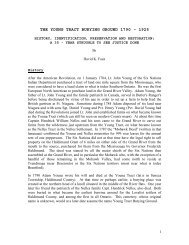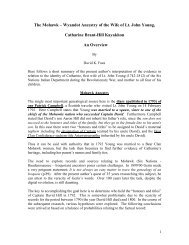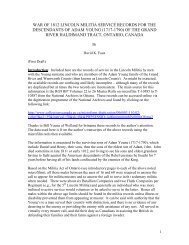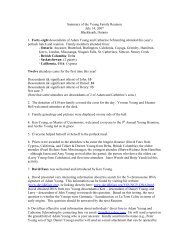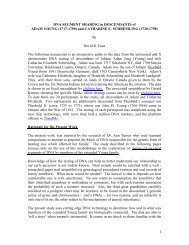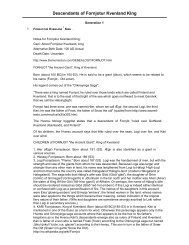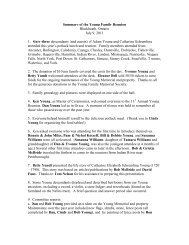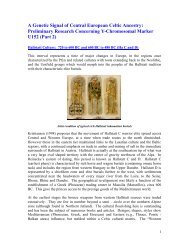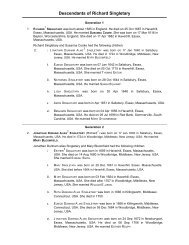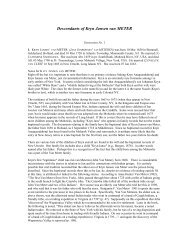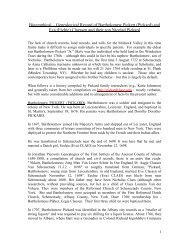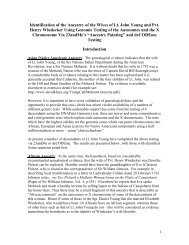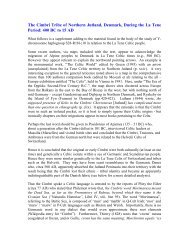Mohawk â Wyandot Ancestry of Lt. John Young's ... - Davidkfaux.org
Mohawk â Wyandot Ancestry of Lt. John Young's ... - Davidkfaux.org
Mohawk â Wyandot Ancestry of Lt. John Young's ... - Davidkfaux.org
- No tags were found...
Create successful ePaper yourself
Turn your PDF publications into a flip-book with our unique Google optimized e-Paper software.
<strong>John</strong> Norton reported in his diary that Joseph Brant's ancestors on both the mother andfather's side were <strong>Wyandot</strong> (Huron) captives adopted by the <strong>Mohawk</strong>. Joseph, although astep – son <strong>of</strong> Brant Canagaradunckwa, adopted Brant’s first name as a surname. TheOnondaga adopted many Huron after the raids <strong>of</strong> the 1640s, as did the <strong>Mohawk</strong>. JosephBrant's son Joseph also reported to William Allen that his father's step - father was a chiefwho was denominated an Onondaga Indian (Dictionary <strong>of</strong> Canadian Biography, Vol. V,“Thanendanegea”). The names Canagaradunckwa (the Indian name <strong>of</strong> Joseph Brant’sstep – father) and Canadiorha appear to have disappeared with the deaths <strong>of</strong> Brant andNicholas, despite the prominence <strong>of</strong> both individuals, possibly because both were<strong>Wyandot</strong> in origin.In exploring the <strong>Wyandot</strong> – Onondaga – <strong>Mohawk</strong> connection, the following observationsmay or may not be relevant. Among the Onondaga the head chief is Atotarho. Alsosachems, but linked as “cousins” and holding a special relationship to Atotarho, areEnneserarenh and Dehatkahthos or Tchatkatons <strong>of</strong> the Beaver Clan (Hale, 1881). Thefirst “cousin” has a name that resembles the <strong>Mohawk</strong> Astawenserontha; and the second“cousin” is remotely similar to Tahatonne or Tahanata. This “cousin” relationship beingsomewhat similar to the relationship between the <strong>Mohawk</strong> titles being highlighted by thebracket used by Ge<strong>org</strong>e Martin to join them (in 1815).Nicholas Brant Canadiorha (son <strong>of</strong> Brant Canagaradunckwa and step – brother to JosephBrant) had ties at Schoharie (a very multicultural <strong>Mohawk</strong> settlement led by those fromCaughnawaga and likely Huron, as well as Oneidas, River Indians, Tuscaroras, andparticularly those from Onaquaga on the Susquehanna River). Here he had one <strong>of</strong> hischildren baptised in 1758, and was also a sponsor for a child <strong>of</strong> his sister Rosina, wife <strong>of</strong>Aront in the same year, it being noted in the record that Nicholas and Margaret were fromCanajoharie (Sievertsen, 1996).Ultimately the “Beaver Tribe” likely represented a very powerful sub - group among the<strong>Mohawk</strong> Bear Clan, and may have attained considerable status in the new community –but not f<strong>org</strong>etting their roots, nor severing their connections to the homeland in Canada,or their distant kin among the <strong>Wyandot</strong>. Since they were fully adopted <strong>Mohawk</strong>s (andthere being relatively few “true” <strong>Mohawk</strong>s), the Huron Bear Tribe may have furnishedthe lineage for the Astawenserontha sachemship, as well as the closely associatedTahatonne / Tahanata sachemship which is outside the original <strong>Mohawk</strong> three from thedays <strong>of</strong> the founding <strong>of</strong> the League (the Five Nations Confederacy) and may have<strong>Wyandot</strong> - Onondaga roots. Among the Huron / <strong>Wyandot</strong>, over the course <strong>of</strong> time, theBear phratry (Bear and Deer clans) was linked to the Turtle phratry (Turtle and Beaverclans) via the division into moieties (halves). These terms roughly meaning “side” usedby anthropologists to signal divisions or groupings between clans each <strong>of</strong> which hadreciprocal duties (e.g., to condole members <strong>of</strong> the other “side”). Hence the Bear andBeaver clans were associated from early days (Sioui, 1999, p.115).There is also archaeological evidence <strong>of</strong> a link between families <strong>of</strong> Upper <strong>Mohawk</strong>s, anda group who appeared to place a special emphasis (symbolic or otherwise). First it40



